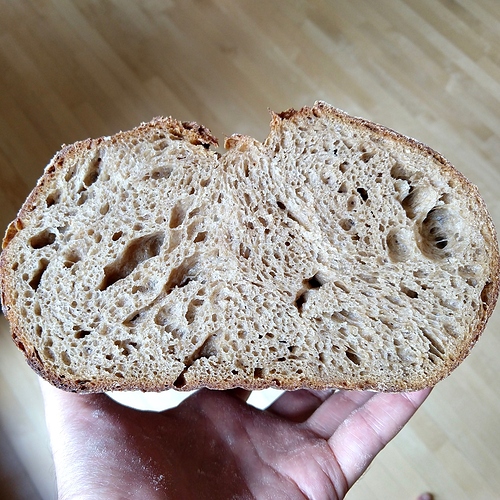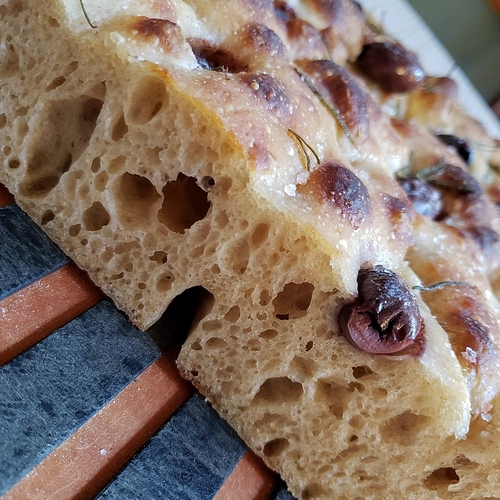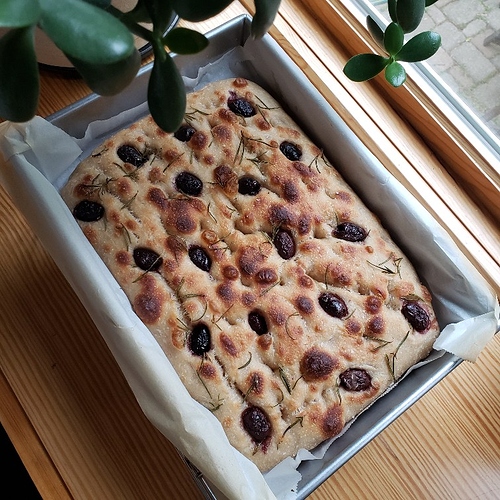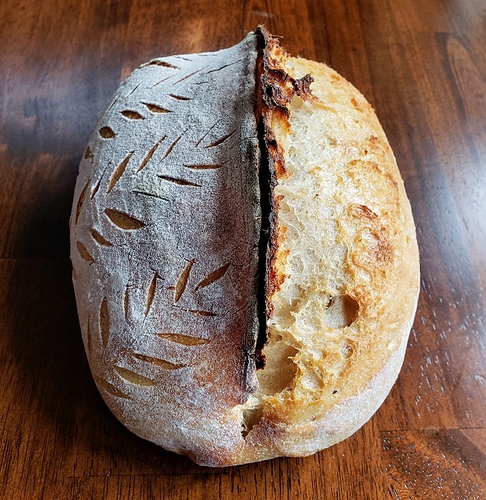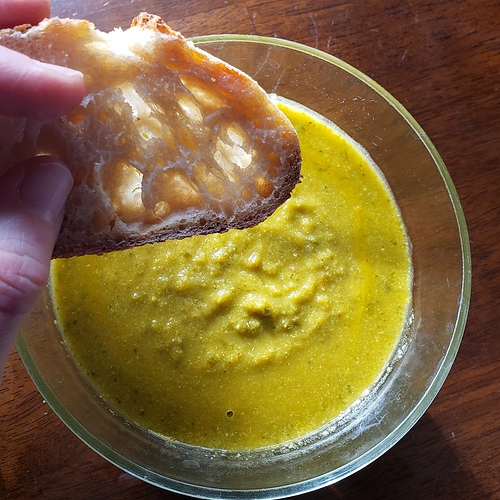You’re correct and not alone in seeing this : )
The ideal experiment would have been four doughs: small unfed, small fed, large unfed, large fed. Here is my earlier response and you may want to read that of @homebreadbaker afterward.
Crumb of this week’s loaf leavened with about 1/2 a teaspoon (< 10g) of unfed (~ 4 weeks now) starter straight from the fridge. This is 100% whole grain home milled flour, 2/3 red fife and 1/3 hard white (all the berries from here at Breadtopia). Bulk proof was about 17 hours at something close to 75 F room temperature. Then after shaping the basket went into the fridge for another ~ 18 hours before baking.
Another week of neglect has not hurt my starter’s ability to leaven bread. This week I used about 1g of starter from the jar in my fridge that has not been fed in 5 weeks.
would these “methods” work for a no-knead sourdough bread?
Absolutely. In fact, No Knead was the method used for the two rounds of baking in the experiment. In discussing method, @homebreadbaker suggested I leave out gluten development efforts in order to ensure just the variable of starter inoculation was being tested. For example, what if I stretched one dough harder or laminated the two doughs at different points in their fermentation – that might have an impact I could wrongly attribute to using a lot or little starter.
(I did an experiment earlier this year that showed that laminating dough for gluten development has a more positive impact when done earlier in the first rise.)
I made sourdough focaccia with the recipe on Breadtopia’s blog, except I tested using a lot of cold, unripe starter. Not particularly old starter, but fed and refrigerated several days prior and not expanded at all.
The recipe calls for 30% starter and you might recall that in this blog post on Challenging Sourdough Starter Convention, I only used small amounts of unfed starter.
Well, now we have another data point: This unfed “macrolevain” turned out great. Nice crumb and tasty, slightly sour flavor.
Here’s a link to the recipe and more about my ingredients and method on this bake:
I used home-milled spelt as the 20% whole grain component instead of Kamut or white sonora wheats. It worked well, with good extensibility and flavor.
I paired the unripe starter with warm water for the dough, and I did four rounds of stretching and folding with a spatula while watching a movie – thanks @Leah1 for reminding me of spatula folding.
Then I put the dough outside in my grill (~60F) overnight.
I got up early and scraped the dough out into an oiled-parchment lined pan, then decorated and baked the focaccia a few hours later.
This all makes interesting reading and points toward some useful changes (simplifications) in technique. I have a starter that I received in 1999 and have managed to keep going since then. The difference is that it is fed with flour and milk rather than flour and water. My question is, should I expect that it will work with the approach and the formulas outlined in this thread? Or, is it more likely that it will work better with formulas that include milk in their makeup?
I’ve been surprised at how resilient the yeast and bacteria when you change the food source, so I would give it a go. Certainly many recipes go the other direction, with a flour and water starter being given the task of leavening a milky dough.
I tried this approach with the Broa de Milho and haven’t been thrilled with the results. I think it is time to make a water-based starter and try that out. I’ve killed the ones I made a couple of years ago, but the pineapple-juice+rye flour recipe is a sure thing. Ever onward.
I’ve been baking with commercial flour and with 100% home milled flour using 1 - 2% starter since the original YouTube with great success. At room temp nothing happens for about 15 hrs then ferment is complete in approx 4 - 5 hrs. I cold bake in tins at up to 90% hydration
Here’s a 3% inoculation bread:10g starter for 400g flour.
Bulk fermentation was at cool room temps about 20 hours.
No gluten development apart from mixing the ingredients (and shaping tight).
25% home-milled whole grain hard white wheat and 75% bread flour.
Lovely. Have you seen, or heard of, Yohan Ferrant’s “Do Nothing Bread”?
High hydration, very low inoculation, a 24 hour (I think) bulk ferment with time doing all the work. He claims this brings out the best in a bread health and taste wise.
Shaping too is quick and nothing special. The idea is that there is very little handling.
Yes, Ferrant (actually Guy Ceor talking about Ferrant) started me on the microlevain kick and @homebreadbaker added the unfed cold element to the picture.
Here’s an old thread with some pics @wendyk320 did experiments with it too.
Hi Melissa, the folks at Eat Your Books have featured sourdough this week. If folks on this blog haven’t seen the site, it is a really useful site and an interesting online community of folks who love food, cooking, and cookbooks. I linked this blog and site on a comment in their blog, as well. Thanks for all you do, particularly about sourdough. Stay well!
That’s a really neat website - thanks for sharing it and for posting Breadtopia’s research there!
Wow this is shocking to me these experiments.  Very revealing.
Very revealing.  I guess based on these results, I can be a lot more flexible with maintaining my starter, and how much to use. I never would have thought an old starter at such a small amount would have similar results. I’ll now have to do my own experiments With a more lax approach to my starter, and see if I have similar results. I also deduct that you’re using a lot of intuition as to when each step is concluded before moving on, as opposed to set times which is also very revolutionary for me
I guess based on these results, I can be a lot more flexible with maintaining my starter, and how much to use. I never would have thought an old starter at such a small amount would have similar results. I’ll now have to do my own experiments With a more lax approach to my starter, and see if I have similar results. I also deduct that you’re using a lot of intuition as to when each step is concluded before moving on, as opposed to set times which is also very revolutionary for me 
 Thank you Melissa for taking the time to do these experiments and share the results with us.
Thank you Melissa for taking the time to do these experiments and share the results with us. 
So glad you enjoyed the blog post. And you’re right, observation and experience are what makes it possible to use different starter inoculations. To some degree, all sourdough baking is like that, because we’re not using a packet of standardized dry yeast. And even with measurable yeast, there are variations in the brands and people’s room and water temperatures too.
Good points Melissa, thank you for the replies and expertise as always! 
Somebody pointed me to this post- as it confirms exactly what I have been writing elsewhere. I have been baking with cold starter from the fridge for years, with great results- and am baffled by all the strict rules about feeding times and regimen that people seem stuck on. Sourdough should be easy…
I don’t want to copy and paste the full text here, but I hope it’s OK to provide a link.
https://www.facebook.com/michiel.leijnse/posts/10159532555109045?hc_location=ufi
